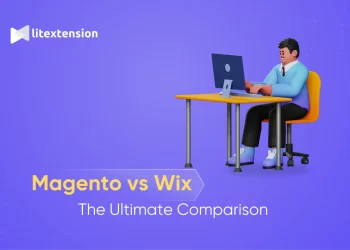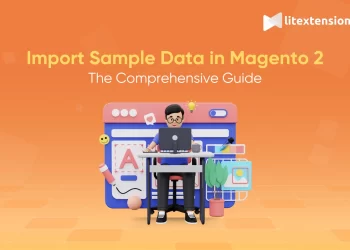What Is Magento and How Does It Work?
Initially released by Varien on March 31, 2008, Magento quickly gained traction, powering over 120,000 online stores and boasting over 2.5 million downloads. So, what is Magento, and what are all the myths around it? Let’s find out with LitExtension through this article.
Magento (also known as Adobe Commerce) is a powerful open-source eCommerce platform designed for businesses that need flexibility, scalability, and advanced customization. As of 2025, Magento powers over 140,000 active websites globally, making it one of the most widely used platforms for large and growing online stores. It offers a robust architecture that allows developers to tailor every aspect of the store experience - from product management to complex integrations. Magento is particularly favored by medium to large enterprises for its extensive features and ability to handle high traffic and large inventories.
In this article, we’ll explore what Magento is, how it works, and break down its core features to help you understand if it's the right fit for your eCommerce needs. Let’s get started!
For better look about what is Magento, please watch this video:
What is Magento: Key Takeaways
- Magento is an open-source eCommerce platform developed in PHP, offering two main editions: Magento Open Source (free) and Adobe Commerce (paid). It provides merchants with a flexible and scalable solution for building and managing online stores.
- Magento operates as a self-hosted platform, requiring users to set up their own hosting environment. It offers extensive customization options through themes and extensions, allowing businesses to tailor their online stores to specific needs.
- The strongest advantage of Magento is its high level of customization and scalability, making it suitable for businesses with complex requirements and large product catalogs.
- The biggest drawback of Magento is the significant technical expertise and resources required for setup and maintenance, which can lead to higher costs compared to other platforms.
- Magento holds approximately 8% of the global eCommerce platform market share as of Q4 2024 to Q1 2025, ranking third after Shopify and WooCommerce.
What's Magento Pricing Plans?
Magento offers two distinct pricing structures depending on the edition you choose: Magento Open Source/Adobe Commerce (the free version) and Adobe Commerce Cloud (the premium, enterprise-grade offering). Understanding these pricing plans is crucial for businesses to determine which solution fits their budget and needs.
With that being said, in the scope of this article on what is Magento, we’ll focus on the pricing of the Adobe Commerce version. This platform is entirely free, but keep in mind that this doesn’t cover the hosting or maintenance costs. You’ll need to choose and manage your own hosting provider, which could range from affordable shared hosting to high-performance dedicated servers.
- Here’s an estimation of how much each element costs:
- Domain name: $10–400/year
- Hosting: From $100/year
- SSL certificate: $50–300/year
- Extension: $60–600/extension
- Development: From $1,800
- Maintenance: $50–100/hour
👉 Read more: Magento pricing - Is it really free & The actual cost.
How Does Magento Work?
Magento is a powerful and flexible eCommerce platform built on a variety of technologies to deliver a comprehensive solution for online businesses.
1. PHP and MVC Architecture
Magento utilizes the Model-View-Controller (MVC) architectural pattern. This structure separates the application's concerns into three distinct parts:
- Model: Manages data and logic related to the application's core functionality (e.g., products, customers, orders).
- View: Handles the presentation of data to the user, displaying information on the storefront and admin panels.
- Controller: Acts as the intermediary between the model and the view, handling user requests and interactions.
2. Frontend (Storefront)
Magento storefront is the public-facing part of your online store where customers browse products, add items to their cart, and complete checkout. Magento's front end is built using HTML, CSS, and JavaScript, ensuring a visually appealing and user-friendly experience.
3. Backend (Admin Panel)
The Magento admin panel is the control center for managing your online store. You can use it to add and manage products, process orders, set up promotions, configure payment gateways, and customize the store's look and feel.
4. Database
Magento stores all data related to products, orders, customers, and configurations in a database (usually MySQL or MariaDB). This database acts as the central repository for all information needed to run the store.
💎 In summary, Magento creates a fully functional eCommerce website by combining a frontend (storefront), backend (admin panel), database, and PHP code. Understanding these core components and their interactions will help you gain a clearer picture of how Magento works and how it can be used to build a successful online store.
👉Additional resource: A complete Magento tutorial & guidelines for beginners.
What Is Magento eCommerce Feature List?
Adobe Commerce, formerly known as Magento, is a widely recognized cloud-based digital commerce platform designed to empower businesses in creating exceptional shopping experiences. With its adaptable and scalable architecture, it caters to the needs of both B2B and B2C businesses, while its headless approach facilitates seamless innovation and customization.
Key functionalities and features of Magento (Adobe Commerce) include:
- Ability to efficiently manage multiple global stores and brands from a unified platform.
- Seamless customer experiences across various digital touchpoints, such as web, mobile, and marketplaces.
- Real-time data collection and sharing for personalized commerce experiences.
- Cloud-based functionality that enhances total cost of ownership.
- Seamless integration with various enterprise systems.
- Headless architecture that enables the deployment of new front-end customer experiences and rapid updates to storefronts.
👉 Further reading: Magento 2 features list to support your growth.
Why Should You Choose Magento eCommerce?
Magento offers numerous compelling reasons to choose it as your eCommerce platform. Below, I will list the key benefits and why Magento might be the right choice for your business.
1. Scalability and Flexibility
Magento is designed to scale with your business. It can handle extensive and complex product catalogs, high traffic volumes, and complex transactions without compromising performance. Magento's modular architecture enables seamless additions of new features and functionalities as your business expands.
2. Customization and Control
Magento has an open-source nature which may give you complete control over the look, feel, and functionality of your store. You can customize virtually every aspect to create a unique brand experience. From design and layout to features and integrations, Magento allows for extensive customization to meet your specific business requirements.
3. Powerful Features and Functionality
Magento is equipped with a wide range of built-in features, including product management, customer management, order processing, marketing tools, and more. Furthermore, you have the option to access an extensive Extension Marketplace offering over 4,000 options to enhance functionality. These options include social media integration, advanced shipping options, and specialized integrations with other business tools.
4. SEO-Friendliness and Marketing Capabilities
Magento is built with SEO best practices to enable easy optimization of your store for search engines and to enhance your organic visibility. Additionally, this platform comes equipped with built-in marketing features such as promotions, discounts, email marketing, and customer segmentation, all geared towards helping you reach your target audience and drive sales effectively.
5. Strong Community and Support
Magento has a strong and supportive community of developers, users, and experts who provide assistance, valuable resources, and effective solutions. Additionally, a wealth of comprehensive documentation, tutorials, and guides are available to aid in learning and troubleshooting. For enterprise-level support, Magento offers dedicated support plans to address intricate issues and ensure seamless operations.
🧐 Who should choose Magento?
- Businesses with complex product catalogs, custom requirements, or high-volume transactions.
- Businesses seeking extensive control over design, functionality, and integrations
- Businesses with development resources for customization and maintenance.
What Can You Sell On Magento?
Magento, now known as Adobe Commerce, is a flexible eCommerce platform that empowers you to sell a wide range of products and services online. Here's a table summarizing the Magento product types and their key characteristics.
|
Product Type |
Description |
Examples |
Variations |
Inventory Management |
| Simple Product | A physical item with a single SKU. | T-shirt (specific size and color), book, laptop model | No | Yes |
| Configurable Product | Appears as a single product but includes options for each variation. | T-shirt (various sizes and colors), laptop with different configurations | Yes | Yes (for each variation) |
| Grouped Product | A collection of multiple standalone products presented as a group. | Furniture set (sofa, loveseat, armchair), different flavors of coffee | No (but includes multiple simple products) | Yes (for each simple product) |
| Virtual Product | Non-tangible product, no shipping required. | Warranty, online subscription, consultation session | Sometimes (e.g., different subscription tiers) | No (usually) |
| Bundle Product | Pre-packaged combination of simple or virtual products. | Computer bundle, gift basket, travel package | Sometimes (customizable options within the bundle) | Yes (for each included product) |
| Downloadable Product | Digital product that can be downloaded after purchase. | E-book, software application, music album | Sometimes (e.g., different file formats) | No (usually) |
| Gift Card (*) | A prepaid card that can be used as payment. | Gift card with a specific value | Can be physical or virtual | Yes (tracking remaining balances) |
(*) Adobe Commerce only
Magento Pros and Cons
We've explored Magento's core functionalities and potential challenges that provided a well-rounded overview of this powerful eCommerce platform.
To recap, let's summarize Magento's advantages and disadvantages in a concise table:
|
Pros |
Cons |
|
|
Bottom Line
In short, Magento is a powerful and highly customizable eCommerce platform best suited for businesses with complex needs and technical expertise. Its flexibility, scalability, and extensive features make it a top contender for building and managing successful online stores.
However, it's crucial to weigh the pros and cons carefully. Magento's complexity and potential costs might not suit everyone.Smaller businesses or those with limited technical expertise might find other platforms easier to use and more budget-friendly. You can always find our list of some best Magento alternatives for further consideration.
Frequently Asked Questions (FAQs)
What is Magento used for?
Magento is used to build and manage online stores. It provides a platform for businesses to sell products and services online, manage inventory, process orders, and engage with customers.
Is Magento owned by Adobe?
Yes, Magento was acquired by Adobe in 2018 and is now part of the Adobe Experience Cloud.
What is Magento now called?
The core platform is still based on Magento, but the official product name is now Adobe Commerce. Under Adobe Commerce, the commercially supported versions are Adobe Commerce Pro and Adobe Commerce Managed Services, while the free version is still called Magento Open Source.
Who should use Magento?
Magento is best suited for medium to large businesses with complex requirements, technical expertise, and a budget for development and maintenance. It's ideal for businesses seeking scalability, flexibility, and customization.
Is it difficult to learn Magento?
Magento has a steeper learning curve compared to simpler platforms. It requires technical knowledge of web development, PHP, and database management. However, ample resources and a large community are available to help.
Is Magento a CRM or CMS?
Magento is primarily an eCommerce platform. While it has some CMS (Content Management System) features for managing website content, it's not a full-fledged CMS like WordPress. It's not a CRM (Customer Relationship Management) system, but it integrates with various CRM solutions.






